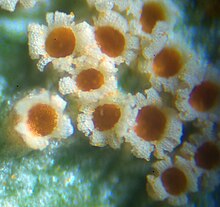| This article needs additional citations for verification. Please help improve this article by adding citations to reliable sources. Unsourced material may be challenged and removed. Find sources: "Aecium" – news · newspapers · books · scholar · JSTOR (January 2017) (Learn how and when to remove this message) |

An aecium (plural aecia) is a specialised reproductive structure found in some plant pathogenic rust fungi that produce aeciospores. Aecia may also be referred to as "cluster cups". The term aecidium (plural aecidia) is used interchangeably but is not preferred.
In some rust fungi such as Phragmidium, aecia lack an outer wall structure (a peridium) but instead produce a diffuse aecium called a caeoma.

In some species of rust fungi with a life cycle including two different host plants, the binucleate spores produced in the aecia cannot infect the current plant host, but must infect a different plant species.
References
- Ulloa, Miguel; Hanlin, Richard T. (2000). Illustrated dictionary of mycology. APS Press. ISBN 0-89054-257-0.
- Fungi. Lilian E Hawker, 1966, Hutchinson University Library
This mycology-related article is a stub. You can help Misplaced Pages by expanding it. |